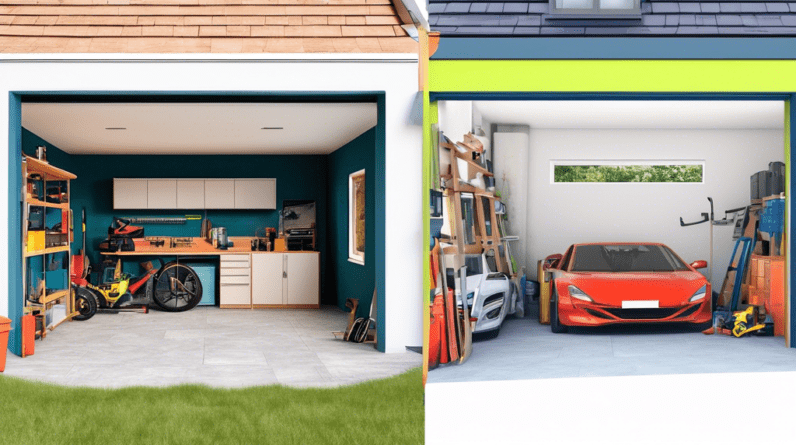
Introduction: Unlock the Potential of Your Garage
Is your garage overflowing with clutter, a forgotten car gathering dust, or simply an underutilized space? Imagine transforming this neglected area into a comfortable and functional living space that perfectly suits your needs and budget. Converting your garage is a fantastic way to add value to your home while creating a versatile area for various purposes. This comprehensive guide will take you through the step-by-step process of converting your garage on a budget, without compromising on quality or style.
Assess Your Needs and Vision
Before diving into the renovation, it’s essential to have a clear understanding of your goals for the space.
- Purpose: Determine the primary function of your converted garage. Will it be a guest bedroom, a home office, a playroom for the kids, or a cozy entertainment area?
- Budget: Set a realistic budget for your conversion project. This will help you make informed decisions about materials, finishes, and labor.
- Style: Consider the existing style of your home and choose a design aesthetic that complements it. Browse online platforms like Pinterest and Instagram for inspiration and create a mood board to visualize your desired look.
Planning and Permits
Proper planning and obtaining the necessary permits are crucial for a successful garage conversion.
- Check Local Regulations: Contact your local building department to inquire about specific regulations and permits required for garage conversions in your area.
- Draw a Floor Plan: Create a detailed floor plan that outlines the layout, electrical and plumbing needs, window placement, and any structural changes.
- Hire Professionals: If your project involves complex electrical, plumbing, or structural work, it’s highly recommended to hire licensed professionals to ensure safety and quality.
Preparing the Garage
Once you have your plans and permits in order, it’s time to prepare the garage for the transformation.
- Clean and Declutter: Empty the garage completely, getting rid of unwanted items and organizing the rest.
- Inspect and Repair: Thoroughly inspect the walls, ceiling, and floor for any damage, cracks, or moisture issues. Address these problems before proceeding.
- Insulation: Proper insulation is vital for creating a comfortable living space. Insulate the walls, ceiling, and garage door with high-quality insulation materials.
Flooring, Walls, and Ceiling
Transforming the bare bones of your garage into a habitable space starts with addressing the flooring, walls, and ceiling.
- Flooring Options: Consider durable and budget-friendly flooring options like laminate, vinyl plank, or engineered hardwood. These materials mimic the look of real wood at a fraction of the cost.
- Wall Treatments: Drywall is a popular choice for garage walls, providing a smooth and paintable surface. Consider textured finishes or wallpaper for added visual interest.
- Ceiling Finishes: Paint the ceiling white or a light color to create a sense of spaciousness. Alternatively, install ceiling tiles or wood planks for a more polished look.
Electrical and Plumbing
Unless your garage is already equipped with adequate electrical and plumbing, you’ll likely need to make upgrades to accommodate your needs.
- Electrical: Determine your electrical requirements based on your intended use of the space. Install sufficient outlets, light fixtures, and consider adding ceiling fans for ventilation. If you’re unsure about electrical work, consult a licensed electrician.
- Plumbing: If you plan on having a bathroom or kitchenette in your converted garage, you’ll need to factor in plumbing costs. This may involve running new pipes, installing fixtures, and connecting to the existing water and sewage lines.
Lighting and Ventilation
Proper lighting and ventilation are crucial for creating a bright, airy, and comfortable living space.
- Natural Light: Maximize natural light by installing windows or enlarging existing ones. Consider adding a skylight or solar tubes to bring in more sunshine.
- Artificial Light: Layer different types of lighting to create a warm and inviting ambiance. Use a combination of ambient, task, and accent lighting.
- Ventilation: Ensure adequate ventilation to prevent moisture buildup and improve air quality. Install exhaust fans, ceiling fans, or consider adding operable windows.
Temperature Control
Maintaining a comfortable temperature year-round is essential for a livable space.
- Heating and Cooling: Depending on your climate and budget, explore different heating and cooling options. Consider extending your existing HVAC system, installing a ductless mini-split, or using space heaters and portable air conditioners.
Finishing Touches
Now comes the fun part—adding those finishing touches that will transform your converted garage into a stylish and inviting living space.
- Paint: Choose a color palette that complements your chosen style and creates the desired mood. Light and neutral colors tend to make spaces feel larger and brighter.
- Window Treatments: Dress up your windows with curtains, blinds, or shades that provide privacy and enhance the overall aesthetics.
- Furniture and Decor: Select furniture and decor that are both functional and stylish. Consider the purpose of the space and choose pieces that reflect your personal taste.
Budget-Friendly Tips
Converting your garage doesn’t have to break the bank. Here are some tips to help you stay within budget:
- DIY When Possible: Tackle tasks like painting, demolition, and basic carpentry yourself to save on labor costs.
- Shop Around for Materials: Compare prices from different suppliers and look for discounts and sales on building materials.
- Repurpose and Upcycle: Get creative and repurpose old furniture, doors, windows, or other materials to add character and reduce costs.
- Prioritize Spending: Focus your budget on essential items like insulation, flooring, and appliances, and allocate less to cosmetic upgrades.
Conclusion: Enjoy Your Transformed Space
Converting your garage into a functional and stylish living space is an excellent way to add value to your home and create a versatile area that meets your unique needs. By following these steps and keeping your budget in mind, you can transform this underutilized area into a beautiful and functional extension of your home. Enjoy the process and take pride in your accomplishment!






